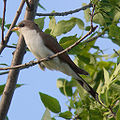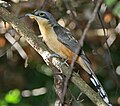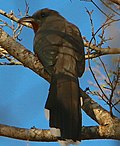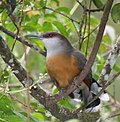Superregnum: Eukaryota
Cladus: Unikonta
Cladus: Opisthokonta
Cladus: Holozoa
Regnum: Animalia
Subregnum: Eumetazoa
Cladus: Bilateria
Cladus: Nephrozoa
Superphylum: Deuterostomia
Phylum: Chordata
Subphylum: Vertebrata
Infraphylum: Gnathostomata
Megaclassis: Osteichthyes
Cladus: Sarcopterygii
Cladus: Rhipidistia
Cladus: Tetrapodomorpha
Cladus: Eotetrapodiformes
Cladus: Elpistostegalia
Superclassis: Tetrapoda
Cladus: Reptiliomorpha
Cladus: Amniota
Classis: Reptilia
Cladus: Eureptilia
Cladus: Romeriida
Subclassis: Diapsida
Cladus: Sauria
Infraclassis: Archosauromorpha
Cladus: Crurotarsi
Divisio: Archosauria
Cladus: Avemetatarsalia
Cladus: Ornithodira
Subtaxon: Dinosauromorpha
Cladus: Dinosauriformes
Cladus: Dracohors
Cladus: Dinosauria
Ordo: Saurischia
Cladus: Eusaurischia
Subordo: Theropoda
Cladus: Neotheropoda
Cladus: Averostra
Cladus: Tetanurae
Cladus: Avetheropoda
Cladus: Coelurosauria
Cladus: Tyrannoraptora
Cladus: Maniraptoromorpha
Cladus: Maniraptoriformes
Cladus: Maniraptora
Cladus: Pennaraptora
Cladus: Paraves
Cladus: Eumaniraptora
Cladus: Avialae
Infraclassis: Aves
Cladus: Euavialae
Cladus: Avebrevicauda
Cladus: Pygostylia
Cladus: Ornithothoraces
Cladus: Ornithuromorpha
Cladus: Carinatae
Parvclassis: Neornithes
Cohors: Neognathae
Cladus: Neoaves
Ordo: Cuculiformes
Familia: Cuculidae
Genus: Coccyzus
Species: C. americanus - C. erythropthalmus - C. euleri - C. ferrugineus - C. lansbergi - C. longirostris - C. melacoryphus - C. merlini - C. minor - C. pluvialis - C. rufigularis - C. vetula - C. vieilloti
Name
Coccyzus Vieillot, 1816
Synonyms
Hyetornis Sclater,1862
Saurothera Vieillot, 1816
References
Vieillot, L.J.P. 1816. Analyse d'une nouvelle ornithologie élémentaire. 70 pp. Paris: Deterville. P.28 BHL Reference page.
Coccyzus is a genus of cuckoos which occur in the Americas. The genus name is from Ancient Greek kokkuzo, which means to call like a common cuckoo.[1] These include the lizard cuckoos formerly included in the genus Saurothera.
Species and taxonomy
The species in taxonomic order are:
| Image | Common Name | Scientific name | Distribution |
|---|---|---|---|
 |
Black-billed cuckoo | Coccyzus erythropthalmus | Eastern North America, the Caribbean, Central America, and the Andes |
 |
Yellow-billed cuckoo | Coccyzus americanus | southern United States |
| Pearly-breasted cuckoo | Coccyzus euleri | Argentina, Bolivia, Brazil, Colombia, Ecuador, French Guiana, Guyana, Paraguay, Suriname, Peru, and Venezuela | |
 |
Mangrove cuckoo | Coccyzus minor | southern Florida in the United States, the Bahamas, the Caribbean, both coasts of Mexico and Central America, and the Atlantic coast of South America as far south as the mouth of the Amazon River. |
| Cocos cuckoo | Coccyzus ferrugineus | Costa Rica | |
 |
Dark-billed cuckoo | Coccyzus melacoryphus | Argentina, Bolivia, Brazil, Colombia, Ecuador, French Guiana, Guyana, Paraguay, Peru, Suriname, Trinidad and Tobago, Uruguay and Venezuela |
| Grey-capped cuckoo | Coccyzus lansbergi | Aruba, Colombia, Ecuador, Netherlands Antilles, Panama, Peru, and Venezuela. | |
 |
Chestnut-bellied cuckoo | Coccyzus pluvialis | Jamaica |
 |
Bay-breasted cuckoo | Coccyzus rufigularis | Dominican Republic |
 |
Great lizard cuckoo | Coccyzus merlini | The Bahamas (on Andros, Eleuthera and New Providence) and Cuba |
 |
Puerto Rican lizard cuckoo | Coccyzus vieilloti | Puerto Rico |
 |
Jamaican lizard cuckoo | Coccyzus vetula | Jamaica |
 |
Hispaniolan lizard cuckoo | Coccyzus longirostris | Hispaniola (both Haiti and the Dominican Republic) |
The genera Saurothera (the lizard cuckoos) and Hyetornis (chestnut-bellied and bay-breasted cuckoos) were lumped with Coccyzus by the American Ornithologists' Union in 2006.
On the other hand, the ash-colored cuckoo and dwarf cuckoo – at one time separated in Micrococcyx – have been found to be closest relatives of the little cuckoo, formerly in Piaya. These three are now again placed in the reinstated genus of the latter, Coccycua.
Description and ecology
These birds are of variable size with slender bodies, long tails and strong legs. Many have black and white undertail patterns. They occur in a variety of forests, woodlands or mangroves.
Coccyzus cuckoos, unlike many Old World species, build their own nests in trees and lay two or more eggs. Yellow-billed and black-billed cuckoos occasionally lay eggs in the nests of other birds, but are not obligate brood parasites like the common cuckoo of Eurasia.
Northern species such as yellow-billed and black-billed cuckoos are strong migrants, wintering in Central or South America, and occasionally wander to western Europe as rare vagrants, but the tropical Coccyzus cuckoos are mainly sedentary.
These are vocal species when breeding, with persistent and loud calls. They feed on large insects such as cicadas, wasps and caterpillars (including those with stinging hairs or spines which are distasteful to many birds). Lizard cuckoos are large and powerful species, and mainly take vertebrate prey, especially, as the name implies, lizards.
References
Jobling, James A (2010). The Helm Dictionary of Scientific Bird Names. London: Christopher Helm. p. 112. ISBN 978-1-4081-2501-4.
Retrieved from "http://en.wikipedia.org/"
All text is available under the terms of the GNU Free Documentation License

